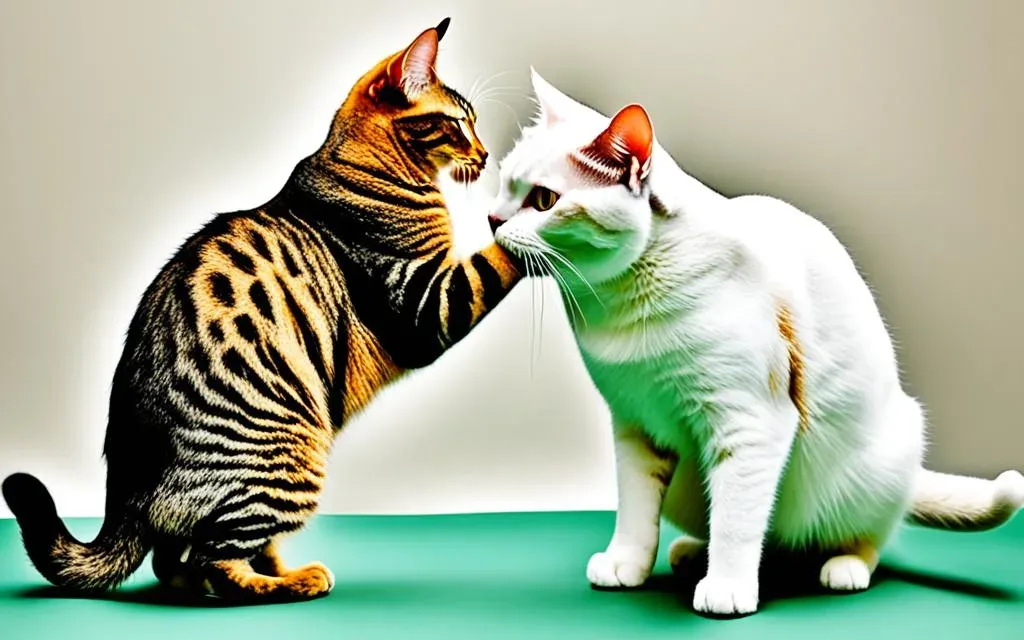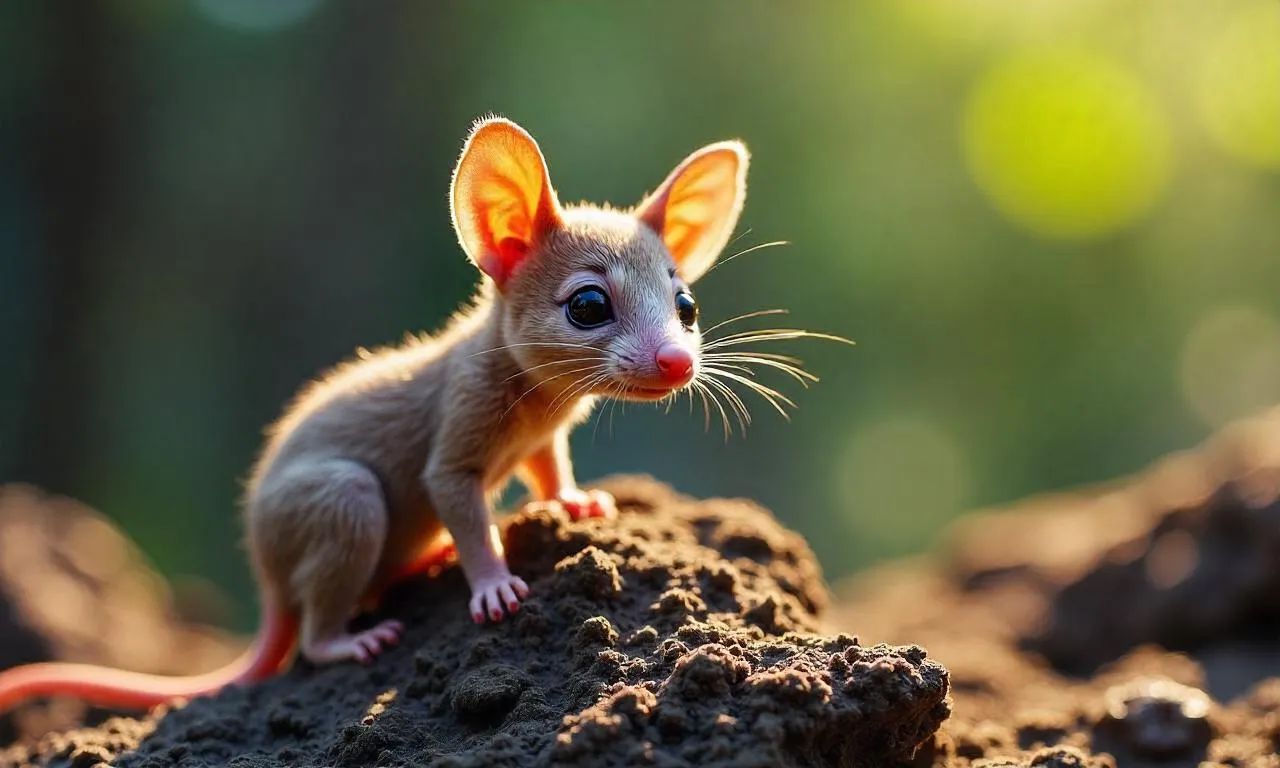How to Stop My Cat From Bullying My Other Cat – Cats don’t always get along well. Sometimes, two cats can develop a dislike for each other. This can lead to fights with hissing, fur flying, and claws out. It might be hard to realize that your cat is the bully. Your cat could be loving with you and picking on the other pets in your home. This situation can stress out everyone.
It’s a common issue, with up to 27% of cats in shelters showing aggression. Recognizing and stopping feline bullying is crucial. Some bullies are quiet, making life hard for their housemates in subtle ways. So, knowing the signs of feline bullying is vital to solve the issue.
Table of Contents
ToggleRecognizing Signs of Feline Bullying
Knowing the signs of cat bullying is key to stopping it. Cat bullies may hiss, growl, chase, or hit other cats. This behavior isn’t always just play. If it’s constant and the target is weaker, your cat might be asserting dominance.
Resource Guarding
Your cat might act out if they hog things like the litter box, keeping others away. They do this to make clear they’re in charge at home.
Destructive Behaviors
If your cat scratches up your stuff, they might be claiming their space. It’s a way of saying, “This is mine.”
Spotting signs like these can help make your home more peaceful. Addressing the root of the issue is critical to happier pets.
Understanding the Causes of Cat Bullying
Figuring out why cats bully each other is key to solving this problem. Things like genes and the type of cat can make some more likely to be aggressive. But, most of a cat’s aggression comes from their past or how they were introduced to other cats.
Genetics and Breed Tendencies
Some cat breeds are known to show more aggression because of their genes. For instance, studies indicate that Siamese and Persian cats might show more aggression because of their genetic makeup. But, a cat’s breed doesn’t entirely predict how they’ll act. Their environment and early interactions with other cats and people are crucial in shaping their behavior.
Lack of Socialization
When a cat isn’t around other cats or people during the right time (usually when they’re 2-7 weeks old), it can lead to problems. They might have trouble getting along with other cats. This lack of early interaction can lead to bullying behaviors later on.
Fear and Territoriality
Many cat bullying cases happen because they’re afraid or they’re trying to protect their space. Cats might bully if they feel their territory is at risk. This could be because a new cat is around or they don’t have enough food, water, or clean litter boxes. It’s important to deal with these fears and the need to protect their territory to stop bullying.
Calming and Preventing Aggressive Behaviors
Want a more chill home? Make sure your cats play a lot. Use toys and other things to make them think and move. This makes them less likely to fight.
A Comfort Zone Calming Diffuser can make them feel safe. It copies a cat’s scent, calming them. Shutting curtains or using sprinklers can scare away stress-causing stray cats.
Providing Enrichment
Give your cats toys, posts to scratch, and things to climb. This keeps them busy and happy. It also stops them from fighting by letting them use their natural instincts.
Play with your cats and use toys that make them hunt. This channels their energy in a good way.
Managing Stress Levels
Tackling stress in your cats’ home helps keep the peace. Make sure they have separate food, water, and litter. This cuts down on fights over who owns what.
Give each cat their own special space, like a perch by a window. This helps them feel safe. It lowers their stress and stops fights.
Neutering and Spaying
Fixing your cats can make a big difference in their behavior. It lowers hormone-driven aggression. It also keeps them healthier and less likely to fight over space.
how to stop my cat from bullying my other cat
If one of your cats is bullying another, it’s crucial to act fast. This issue can quickly get worse. It might harm your cats’ health. But with patience and a clear plan, we can make things better.
First, find out why your cat is bullying. Is it because they feel scared or don’t have enough space? Figuring this out is the first step to solving the problem. By removing what’s causing the bad behavior, your home can become peaceful again for all your cats.
There are many steps you can take. Giving your cats fun things to do and calming their stress can help. Also, consider neutering or spaying your cats. These steps can reduce bullying. Techniques like building trust with your cats through gradual steps can make a big difference. With the right methods, your cats can learn to get along.
Creating a Peaceful Multi-Cat Household
Creating peace among many cats is key. Every cat must have its own space. This limits fights and helps make a calm home with multiple cats.
Separating Resources
Give each cat its own food, water, and litter box. This stops fights over essential things. Place these around your home so cats can use them without issues.
Establishing Personal Spaces
Cats love having places of their own. Create spots like cat trees and quiet corners. This reduces fighting between cats over their living areas.
Supervising Interactions
Let cats play, but watch them. Stop any potential fights early. Use toys or treats to distract cats if they start to argue. This keeps the peace among your group of cats.
Introducing Pheromone Therapy
Pheromones are special chemicals used by species to talk to each other. You can get a special diffuser for cats from pet stores. It can help lower stress and make your cats less likely to fight. Pheromones make the area calm, so cats are less aggressive and more friendly.
Cats become calmer and don’t fight over space with these diffusers. They copy the scents of relaxation and safety that cats naturally produce. So, your home becomes a more relaxing place for your furry friends. This helps reduce bullying among them.
Using pheromones is a soft way to help your cats get along better. It’s a step towards a happy home where cats don’t bully each other. Hindering aggression with pheromone therapy makes your cats live together in peace.
Positive Reinforcement Techniques
When looking at cat bullying, a positive approach works best. By praising good actions, we boost the bond between our cats. This encourages them to get along better. Punishing cats, on the other hand, can make things worse. It might make them more anxious and afraid.
Rewarding Good Behavior
It’s key to reward our cats when they’re calm and friendly with each other. This means giving them treats and saying good things. These rewards show them that being nice has benefits. As they keep getting these rewards, they’re likely to keep up the good work. This creates a peaceful atmosphere among our cats.
Avoiding Punishment
Punishing cats for bullying isn’t the way to go. We should focus on why they’re aggressive instead. Punishing can make them even more scared and worried. This often results in more fighting. Going with a positive method helps our cats learn how to be civil. This way doesn’t stress them out.
Systematic Desensitization and Re-Introduction
Systematic desensitization helps cats get used to each other again in a gradual way. It uses positive actions to make friends and stay calm. The first step is to make separate but comfy spaces for the cats. Each space should have its own things like litter boxes and toys.
Setting Up Separate Spaces
Separate spaces help cats feel safe and lower the chance of fights. With each room having essentials like litter boxes, the cats can get used to the other’s smell. They can hear each other, which starts getting them used to sharing the house again.
Gradual Exposure and Rewards
When cats are okay in their own spaces, we can introduce them slowly. They might sniff each other under a door at first. Then, we give them treats and praise for staying calm. Playing together, under watch, with toys can also improve things. If there are any fights, we stop and try again later.
This approach, mixed with rewards, can prevent one cat from bullying another. It aims to make a peaceful home for all. It takes time and work but can be a good way to fix issues when cats meet again.
Behavior Modification Programs
To stop cat bullying, positive reinforcement works best. You can reward the cat for not being aggressive. A certified animal behaviorist can help make a program just for your cats.
Working with a Professional
Getting help from a cat behaviorist is a smart move. They figure out why the bullying happens and create a plan. This plan focuses on what makes your cats tick.
Reinforcing Desired Behaviors
Avoid punishing your cats to change their behavior. Instead, reward good actions like peaceful interactions. For example, give the bully cat their own space near the litter box to avoid fights.
With time, and the right help, you can improve your cats’ behaviors. This can lead to a more peaceful home for your furry friends.

Conclusion
Stopping cat bullying means using more than one method. We tackle the main issues and teach cats good behaviors. With the right resources, personalized spaces, calming pheromones, and slowly getting the cats used to each other, we can make a better home for every cat. It takes time and steady work. But, it is possible to end your cat’s bullying and help them all get along well.
By following the advice on how to stop cat bullying, we aim for peace. We work hard to know why bullying happens and to stop it. This will make your home a safer and happier place for all your cats.
The main aim is to stop cat bullying completely. We use many helpful ways, like keeping your cats busy, easing their stress, and encouraging good behavior. By doing these things, you can [conclusion on stopping cat bullying]. This leads to a home full of joy, with cats that are friends.
FAQ
What are the common signs of feline bullying?
Common cat bullying signs include hissing, growling, and chasing. They might swat or attack others. Some cats rule over litter boxes or destroy things to show they’re boss.
What are some of the underlying causes of cat bullying?
Aggressive cat behavior can be due to genetics or early life experiences. This includes how they were raised and if they saw aggression. Fear and the need to protect their territory also play a big part.
How can we create a more relaxed and peaceful environment for multiple cats?
To keep the peace, make sure there are enough resources for all cats. This includes food, water, and places to hide. Use pheromone diffusers and positive reinforcement to make your home a happy place for all.
What are some effective methods to stop one cat from bullying another?
Rewards for good behavior help a lot. Slowly getting the cats used to each other again can also work. With the advice of a professional, you can often get past bullying.
Why is it important to address cat bullying quickly?
It’s vital to deal with bullying early to avoid bigger fights that hurt your pets. Solving the problem soon with many different methods makes a better living space for all the cats.
















